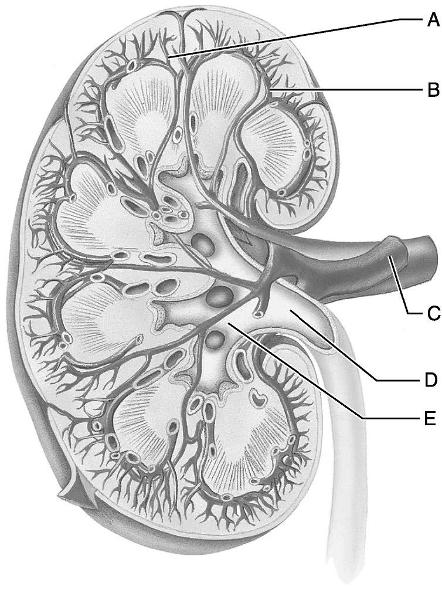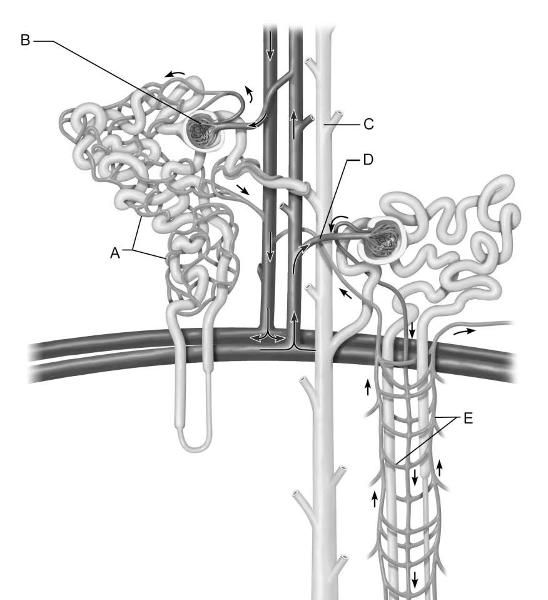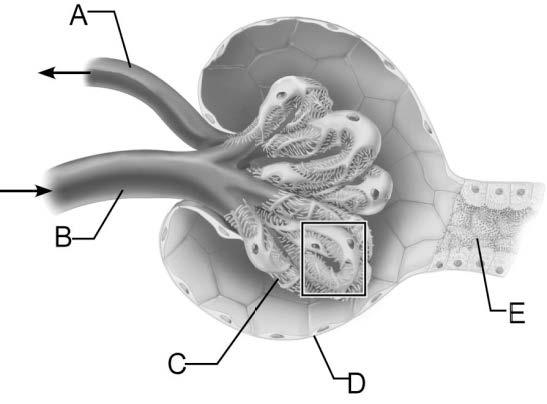
Identify the letter that indicates the major calyx.
A) A
B)
B
C) C
D) D
E) E
E

Identify the letter that indicates the blood vessel that branches
from the abdominal aorta
carrying oxygenated blood to the
kidney.
A) A
B) B
C) C
D) D
E) E
C

Identify the letter that indicates the blood vessels that delineate
the cortex from the medulla.
A) A
B) B
C) C
D)
D
E) E
B

Identify the letter that indicates an expanded portion of the
ureter.
A) A
B) B
C) C
D) D
E) E
D

Identify the letter that indicates a cortical radiate artery.
A)
A
B) B
C) C
D) D
E) E
A

Identify the letter that indicates the afferent arteriole.
A)
A
B) B
C) C
D) D
E) E
D

Identify the letter that indicates the vasa recta.
A) A
B)
B
C) C
D) D
E) E
E

Identify the letter that indicates the glomerulus.
A) A
B)
B
C) C
D) D
E) E
B

Identify the letter that indicates blood vessels that absorb solutes
from the convoluted tubules.
A) A
B) B
C) C
D)
D
E) E
A

Identify the letter that indicates the region of the nephron with
receptors sensitive to
antidiuretic hormone (ADH).
A)
A
B) B
C) C
D) D
E) E
C

Identify the letter that indicates the parietal layer of glomerular
capsule.
A) A
B) B
C) C
D) D
E) E
D

Identify the letter that indicates the proximal convoluted
tubule.
A) A
B) B
C) C
D) D
E) E
E

Identify the letter that indicates the efferent arteriole.
A)
A
B) B
C) C
D) D
E) E
A

Identify the letter that indicates the visceral layer of the
glomerular capsule.
A) A
B) B
C) C
D) D
E) E
C

Identify the letter that indicates blood vessels covered by
podocytes.
A) A
B) B
C) C
D) D
E) E
C
Knot of capillaries that directs blood into the efferent
arteriole.
A) arcuate arteries
B) cortical radiate
arteries
C) glomerulus
D) afferent arterioles
E)
peritubular capillaries
B
The medial concave cleft in which vessels, ureters, and nerves
enter/leave the kidney.
A) cortex
B) hilum
C) renal
corpuscle
D) renal capsule
E) sinus
B
A large fat-filled space within the kidney that also contains the
renal pelvis, blood vessels,
and nerves.
A) sinus
B)
convoluted tubules
C) renal corpuscle
D) renal
pyramids
E) cortical columns
A
Cup-shaped tubes that enclose the papillae of the pyramids.
A)
major calyx
B) minor calyx
C) renal sinus
D) renal
pelvis
E) cortical columns
B
85% of nephrons are described by this term that relates to their
location in the kidney.
A) sinusoidal
B) trabecular
C)
medullary
D) cortical
E) extrinsic
D
Region of the distal tubule that monitors concentration of the
filtrate.
A) vasa recta
B) collecting duct
C) macula
densa
D) mesangial
E) extraglomerular
C
The descriptive term for the location of the kidneys relative to the
abdominal cavity.
A) retroperitoneal
B)
intraperitoneal
C) extraabdominal
D) supraperitoneal
E) subcapsular
A
Contraction of this muscle forces urine from the bladder.
A)
cremaster
B) detrusor
C) diaphragm
D) vesicular
E) dartos
B
Ladderlike looping blood vessels within the medulla.
A) vasa
vasorum
B) peritubular capillaries
C) cortical
radiate
D) vasa recta
E) interlobular
D
Blood vessel that contains granular cells involved in blood pressure
regulation.
A) afferent arteriole
B) efferent
arteriole
C) segmental artery
D) macula densa
E)
extraglomerular mesangial
A
Which of the following is not normally found in urine?
A)
urea
B) glucose
C) uric acid
D) creatinine
B
If you looked closely at the tip of a renal papilla with a hand lens,
the hundreds of little
openings you would see on its surface
are
A) minor calyces.
B) renal sinuses.
C) openings of
papillary ducts.
D) glomeruli.
C
Vessels and nerves enter and leave the kidney through the
A)
fibrous capsule.
B) lateral convex surface.
C) inferior
surface.
D) medial hilum.
D
The most superficial layer of the kidney is the
A)
cortex.
B) medulla.
C) renal pyramids.
D) renal papilla.
A
How much of the fluid filtered by the kidney actually becomes
urine?
A) 1%
B) 10%
C) 50%
D) 99%
A
Which of the following supportive tissues is most
superficial?
A) fibrous capsule
B) pararenal fat
C)
perirenal fat
D) renal fascia
B
Before it enters the ureter, urine collects in the
A) renal
sinus.
B) renal pelvis.
C) renal cortex.
D) renal pyramids.
B
Infection of the renal pelvic and calyces is known as
A)
nephritis.
B) cystitis.
C) hydronephritis.
D) pyelitis.
D
Which vessels lie within the renal columns?
A) arcuate
arteries
B) cortical radiate arteries
C) interlobar
arteries
D) segmental arteries
C
Which of the following is not part of the filtration
membrane?
A) basement membrane
B) capillary
endothelium
C) filtration slit diaphragm
D) granular cells
D
Which of the following processes does not participate in the
production of urine in the
kidney?
A) filtration
B)
secretion
C) evaporation
D) resorption
C
Which of the following is not found in the renal corpuscle?
A)
the glomerulus
B) the nephron loop
C) glomerular
capsule
D) podocytes
B
The only embryonic kidney that survives into adulthood is the
A)
pronephros.
B) mesonephros.
C) metanephros.
D) paranephros.
C
The function of the collecting duct is to
A) contract its
muscular walls to expel urine from the cortex.
B) determine the
final volume and concentration of urine.
C) drain blood from the
kidney and deliver it to the renal vein.
D) transport resorbed
water back into the cardiovascular system.
B
The kidneys lie behind the ________ cavity.
A) abdominal
B)
pelvic
C) thoracic
D) cranial
A
The name of the inferior of the three openings in the trigone of the
bladder is the
A) ureteric orifice.
B) urachus
opening.
C) internal urethral orifice.
D) detrusor.
C
Renin is produced in
A) the glomerulus.
B) the renal
medulla.
C) the granular cells.
D) glomerular capsules.
C
The mucosal folds in the bladder (rugae)
A) act to increase the
surface area for absorption.
B) thicken the bladder wall so that
it does not burst.
C) are not present in life, only in
cadavers.
D) have the same basic function as transitional
epithelium—accommodating stretch as the
bladder fills.
D
Why are urinary tract infections more common in females than in
males?
A) In males the urethra is made up of three regions,
whereas in females it is made of only one.
B) In females the
urethra is attached to the anterior vaginal wall by connective
tissue.
C) In females the urethra is shorter than in
males.
D) In males the urethra is shared by the both the
reproductive and the urinary systems, whereas
in females it is
part of the urinary system only.
C
Which of the following conditions is most often seen in elderly males
with prostatic
hyperplasia?
A) urge incontinence
B)
overflow incontinence
C) urinary retention
D) stress incontinence
C
Which of the following would not inhibit micturition?
A)
stimulation of the somatic motor neurons to the external urethral
sphincter
B) activation of the sympathetic pathways
C)
relaxation of the internal urethal sphincter
D) relaxation of the
detrusor muscles
C
Which segment of the nephron has a simple squamous
epithelium?
A) ascending limb of the nephron loop
B)
descending limb of the nephron loop
C) distal convoluted
tubule
D) proximal convoluted tubule
B
An important difference between a cuboidal epithelial cell of the
proximal versus the distal
convoluted tubules is that
A) the
former only secretes, the latter only filters.
B) one lies in the
renal cortex, the other in the medulla.
C) only one has a folded
basolateral membrane containing enzymes for ion transport.
D) the
proximal tubule cells have long microvilli that are fewer than or
absent from the distal
tubule cells.
D
An important difference between the peritubular capillaries and the
vasa recta in the kidney
is that
A) only the vasa recta are
supplied by efferent arterioles.
B) the vasa recta drain into
arterioles, whereas the peritubular capillaries drain into
venules.
C) the vasa recta are involved in filtration, whereas
the peritubular capillaries are involved in
resorption.
D)
the vasa recta are in the medulla, whereas the peritubular capillaries
are in the cortex.
D
From which embryonic tissue layer(s) does the kidney arise?
A)
ectoderm
B) mesoderm
C) endoderm
D) all three layers
B
Which of the following is not usually associated with the formation
of renal calculi?
A) increased intake of calcium
B)
polyurea
C) dehydration
D) bacterial infection
B
The left renal vein ________ the right renal vein.
A) is shorter
than
B) is the same length as
C) is longer than
D)
carries less blood than
C
Which of the following statements about the urinary bladder is
false?
A) In females, the bladder lies posterior to the uterus
but anterior to the rectum.
B) The ureters attach to the bladder
through oblique posterolateral orifices.
C) Two ureteral openings
and the internal urethral orifice bound the trigone of the
bladder.
D) When empty, the bladder lies inferior to the
abdominal cavity.
A
Based on what you know about the location of the kidneys in the
posterior abdominal wall,
the hilum of the kidney must be at the
level of which vertebra?
A) T11 or T12
B) L1 or L2
C)
L4
D) T8
B
Which of the following is found exclusively in the renal
medulla?
A) nephron loop of juxtamedullary nephrons
B)
cortical radiate arteries
C) peritubular capillaries
D)
proximal convoluted tubules
A
The part of the nephron whose epithelial cells are most responsible
for resorption and
secretion is the
A) glomerular capsule
(podocytes).
B) proximal tubule.
C) thin segment.
D)
distal tubule.
B
The layer of podocytes is the same as the
A) parietal
layer.
B) glomerulus.
C) visceral layer of glomerular
capsule.
D) capsular space.
C
Of the following, the only epithelial type that does not line the
urethra is
A) simple squamous.
B) pseudostratified
columnar.
C) stratified squamous.
D) stratified columnar.
A
Which of the following statements about the internal urethral
sphincter is false?
A) It is a thickening of the detrusor
muscle.
B) It is located superior to the prostatic urethra in
males.
C) It is not consciously controlled.
D) It is
surrounded by the urogential diaphragm.
D
Pyelography is
A) kinking of the ureter.
B) a type of X-ray
procedure (radiology).
C) a way to cure kidney stones.
D)
failure of the embryonic kidney to ascend.
B
Arteries that branch to form the afferent arterioles to the glomeruli
are
A) segmental arteries.
B) arcuate arteries.
C)
cortical radiate arteries.
D) interlobar arteries.
C
Which of the following structures is most numerous within a
kidney?
A) cortical radiate arteries
B) minor
calyces
C) renal corpuscles
D) renal papillae
C
The embryonic urogenital sinus
A) derives from the
cloaca.
B) gives rise to the anus.
C) gives rise to the
rectum.
D) gives rise to the ureters.
A
The ureters develop from
A) the cloaca.
B) the urogenital
sinus.
C) pronephric nephrons.
D) a duct that branches from
the mesonephric duct.
D
The external urethral sphincter is located
A) at the external
urethral orifice.
B) at the junction of the bladder wall and
urethra.
C) at the ureteral orifice.
D) at the urogenital diaphragm.
D
The condition in which the metanephros has failed to ascend
is
A) horseshoe kidney.
B) polycystic renal disease.
C)
hydronephrosis.
D) pelvic kidney.
D
During a dissection, Arnie saw the ureters entering the lateral
corners of the bladder but
found the internal openings of the
ureters in the trigone near the midline of the bladder.
His
observation necessarily means that
A) the ureters run
medially for some distance within the posterior bladder wall.
B)
the ureters and urethra are really the same tube.
C) each ureter
must have four distinct openings into the bladder.
D) this
bladder had a congenital defect.
A
The parts of the nephron whose epithelial cells contain the most
mitochondria are the
A) renal corpuscle and distal
tubule.
B) proximal and distal tubules.
C) thin segment and
glomerular capsule.
D) vasa recta and collecting tubules.
B
In the micturition reflex, the detrusor muscle is stimulated to
contract by
A) sphincter neurons from the brain.
B)
sympathetic fibers.
C) parasympathetic fibers.
D) visceral
sensory fibers from the vagus.
C
In the juxtaglomerular apparatus, the macula densa belongs to
the
A) terminal nephron loop.
B) glomerulus.
C)
efferent arteriole.
D) visceral layer of the glomerular capsule (podocytes).
A
Another name for the neck of the bladder is the
A) superior
surface.
B) anterior angle.
C) inferior angle.
D) trigone.
C
The longest of the three parts of the male urethra is the
A)
prostatic.
B) membranous.
C) spongy urethra.
D) neck.
C
Which structure(s) is (are) most important for holding the kidney in
place in the abdomen?
A) renal vessels
B) renal
ligaments
C) renal fascia
D) the diaphragm, through its
muscle tone
C
The micturition center is located in the
A) cerebellum.
B)
detrusor muscle layer of the bladder wall.
C) pons of the brain
stem.
D) sacral spinal cord.
C
Cortical nephrons are different from juxtamedullary nephrons in
that
A) they are much less abundant.
B) they produce urine,
whereas juxtamedullary nephrons do not.
C) their nephron loop is
shorter, with a shorter thin segment.
D) they do not have a
proximal convoluted tubule.
C
When Melinda was asked to identify a "mystery" slide on a
histology test, she immediately
identified it as renal cortex
because of the presence of scattered
A) renal corpuscles.
B)
thin segments.
C) renal papillae.
D) vasa recta.
A
Which of the following regions of the nephron is most likely to be
found in the renal
medulla?
A) glomerulus
B) proximal
convoluted tubule
C) distal convoluted tubule
D) collecting duct
D
Urine passes through the
A) kidney hilum to the bladder to the
ureter.
B) renal pelvis to the ureter to the bladder to the
urethra.
C) glomerulus to the ureter to the nephron.
D)
hilus to the urethra to the bladder.
B
An increase in the permeability of collecting tubule cells to water
is due to
A) a decrease in the production of ADH.
B) an
increase in the production of ADH.
C) a decrease in the
concentration of solutes in the blood plasma.
D) the presence of
a salty urine in the bladder.
B
The epithelium lining the urinary bladder that permits distension
is
A) stratified squamous.
B) transitional.
C) simple
squamous.
D) pseudostratified columnar.
B
Which gland sits atop each kidney?
A) pancreas
B)
pituitary
C) adrenal
D) interlobar gland
C
The glomerular capsule and the glomerular capillaries together make up the renal corpuscle.
A) True
B) False
A
Urine flows from the kidney to the bladder by gravity and peristalsis.
A) True
B) False
A
The epithelial cells of the distal convoluted tubule have an abundance of absorptive microvilli.
A) True
B) False
B
The descending thin limb of the nephron loop consists of a simple squamous epithelium.
A) True
B) False
A
In females, the urinary bladder lies anterior to the vagina and uterus.
A) True
B) False
A
The location and length of the urethra are two factors that
contribute to the high incidence of
urinary tract infections in women.
A) True
B) False
A
The urinary bladder, when empty, lies within both the abdominal and pelvic cavities.
A) True
B) False
B
A network of peritubular capillaries surrounds the convoluted tubules
and nephron loop for
the purpose of filtration.
A) True
B) False
B
The internal urethral sphincter is composed of smooth muscle and is
under involuntary
control.
A) True
B) False
A
The kidneys are located just below lumbar vertebrae L2 and L3.
A) True
B) False
B
The correct sequence of arterial blood flow is the renal artery to
the segmental arteries to the
interlobar arteries.
A) True
B) False
A
Venous structures of the kidney mirror those of the arterial circuit,
except for the absence of
segmental veins.
A) True
B) False
A
Urine drains from the kidney in the following sequence: from the
collecting duct to the minor
calyx to the major calyx to the
renal pelvis and then to the ureter.
A) True
B) False
A
The ureters enter the bladder obliquely at the anterolateral corners.
A) True
B) False
B
Cortical and juxtamedullary nephrons can be distinguished by the
absence of a vasa recta in
the cortical nephrons.
A) True
B) False
A